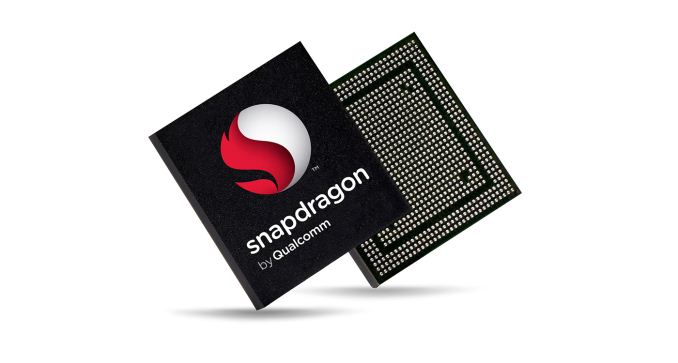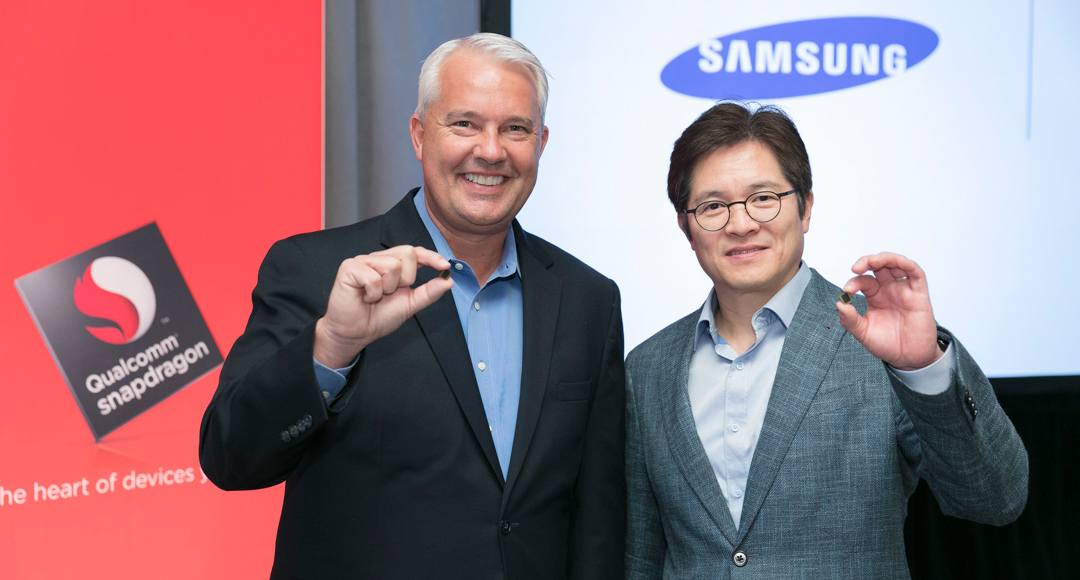Qualcomm Announces Next-Generation Snapdragon 835 SoC Using Samsung’s 10nm Node
by Matt Humrick on November 17, 2016 7:30 AM EST- Posted in
- Smartphones
- Samsung
- Snapdragon
- Qualcomm
- Mobile
- Snapdragon 835

Qualcomm revealed the name of its newest SoC, the Snapdragon 835, at its Snapdragon Technology Summit in New York today. The new SoC replaces the Snapdragon 820/821 at the top of its lineup. While Qualcomm is not yet ready to disclose the specifics about what’s inside the Snapdragon 835, it did confirm one important detail.

Keith Kressin (left) and Ben Suh (right) holding Snapdragon 835, the first 10nm SoC
Keith Kressin, Senior Vice President of Product Management at Qualcomm, took the stage with Ben Suh, Senior Vice President of Foundry Marketing at Samsung Systems-LSI, to announce that the Snapdragon 835 will use Samsung’s 10nm "10LPE" FinFET manufacturing node. We do not know the Snapdragon 835’s power or performance numbers yet, but according to Samsung its 10nm process “allows up to a 30% increase in area efficiency with 27% higher performance or up to 40% lower power consumption.” The switch from 14nm to 10nm, along with other changes, give the Snapdragon 835 a smaller die size than the Snapdragon 820 SoC, and should also help improve battery life.
The Snapdragon 835 is already in mass production and on schedule to appear in commercial devices during the first half of 2017.










65 Comments
View All Comments
lilmoe - Thursday, November 17, 2016 - link
Qualcomm is eastern Asian? Good to know.On another note, Intel's naming convention says wussup.
Meteor2 - Thursday, November 17, 2016 - link
I meant that they're appealing to the China/Japan/Korea market.WPX00 - Thursday, November 17, 2016 - link
As of late they've avoided using xx0 numbers, and xx5 models appear to be all octa-core chips. Which probably means the 835 is an octa-core chip. The jump from 82x to 83x represents the 10nm shrink, and the move from 0 to 5 represents the move from quad-core to octa-core.Drumsticks - Thursday, November 17, 2016 - link
I don't think that makes sense; the Snapdragon 810 is also an octa-core, and the Snapdragon 805 was a quad-core.fanofanand - Thursday, November 17, 2016 - link
And the 808 was a hexacore.WPX00 - Thursday, November 17, 2016 - link
The word "typically" matters here. It's all speculation at the moment.frostyfiredude - Friday, November 18, 2016 - link
Taking a quick look at the snapdragons, its basically random. Lots of XX0 octal core chips and lots of XX5 quads. Then there are the XX2, XX3, XX6 and XX7 sprinkled randomly. And the X5X series stuck in there randomly cuz big numbers are great.SirPerro - Thursday, November 17, 2016 - link
I'm quite more optimistic than that800 to 801 was a small upgrade
800 to 805 was a meh upgrade
805 to 810 was a meh upgrade
810 to 820 was a meh upgrade
820 to 821 was a tiny upgrade
82x to 835 must be YUUUUUGE
rocketbuddha - Thursday, November 17, 2016 - link
810 to 820 was a big upgrade "architecture wise".810 was the first 64 bit high end core from QCOM. It was caught pants down when Apple "Swift" became the first 64 bit ARM ISA Custom core implementation. So they rushed the 810 which was nothing but a standard ARM design of 4xA57+4xA53 with Adreno Graphics and QCM radios at 20nm TSMC.
820 was a custom 4x Kyro core based SOC where QCOM replaced the big little ARM with its own custom cores. It was in addition done in Samsung 14nm FinFET node.
821 is basically a faster version of 820 with a improvement in the modem section to handle higher LTE upload/download.
What we do not know is whether 835 will use a Custom Kyro successor or the ARM A72/A53 based combination. I am leaning towards the latter as it were the former we would have heard it (boasting) by now.
fanofanand - Thursday, November 17, 2016 - link
Qualcomm makes their own for a reason, they didn't with 810 because like you said they simply were caught off guard. I don't think Qualcomm will use stock ARM cores unless it has to, that's how they make their money is through differentiation.